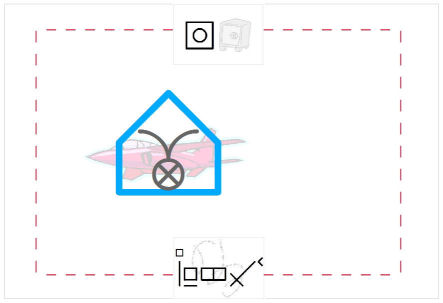Can Blissymbolics be useful in Military Chat?
Sutton Glyphs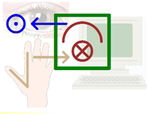
Military Chat?
Some Military Glyphs
Air Traffic Control Glyphs
Bunker and Targeting Glyphs
Where no Pen has gone, Before
Hybrid Visual Language System
Proposed Bliss Software
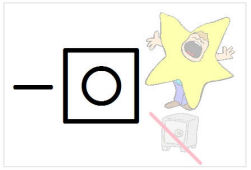 Notice the circle in a box as part of the glyph on the left? It means secret. The circle means speech so the glyph indicates speech in a closed box. The full glyph including the negative sign means 'not secret'. The augmentation from the cartoon image makes intuitive and obvious the meaning of the glyph. It also makes it more colorful and fun. If this were a chatroom, you could get the sense of this entire paragraph just from the augmented glyph. And later, browsing the chat archive would be a breeze because you could get essential recall just by scanning the pictures with glyphs. And of course, you could find the chat messages you're looking for in a snap.
Notice the circle in a box as part of the glyph on the left? It means secret. The circle means speech so the glyph indicates speech in a closed box. The full glyph including the negative sign means 'not secret'. The augmentation from the cartoon image makes intuitive and obvious the meaning of the glyph. It also makes it more colorful and fun. If this were a chatroom, you could get the sense of this entire paragraph just from the augmented glyph. And later, browsing the chat archive would be a breeze because you could get essential recall just by scanning the pictures with glyphs. And of course, you could find the chat messages you're looking for in a snap.
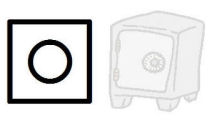
This glyph which means secret, is augmented with the image of a safe to help teach the meaning of the glyph.
I'm promoting Blissymbolics because I don't believe a more integrated visual language system can ever be designed. The uninitiated believe the Bliss glyphs to be cryptic, but that is only because they are so streamlined, composed of the simplest possible geometric shapes and lines. If you stylize them, you add clutter. If you change a glyph in one situation to make it more recognizable, you weaken the integrity of that glyph in the rest of the system. I challenge anyone to surpass the elegant simplicity of Blissymbolics. Yes, some ideas can be expressed less cryptically if drawn more like comic figures, but then you have no system, just a lot of drawings.
Surely any integrated system must draw meaning from semantic primitives. The primitives must be simple shapes or they cannot combine with each other in a nonlinear fashion without becoming complicated monstrosities. And if you cannot combine them into nonlinear patterns, how do you create icons? The semantic primitive approach is unescapable. Otherwise you are right back to an unintegrated pile of icons.
The University of New Mexico is currently researching visual language, including Blissymbolics, with an interest in augmenting military chat. They hope to standardize across the domains of military service and across international language barriers. I've never served in the military, so I may come across as a little naiive at times, but I hope to show off what Blissymbolics can offer for expressing military ideas. I have no doubt the military will implement some kind of visual language system in the years ahead. I hope it is a good one because someday it may trickle down to civilian life and the benefits could be amazing and indeed refreshing. Their goal is efficient, intuitive, unambiguous communication. That can only help this planet.
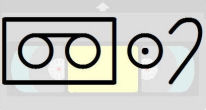
I finally viewed the VaIL video, a month after the conference. It's been a busy summer for me with the Blissymbolics think-tank and also new projects at Symbols.Net and Blissymbolics.us. But it's been extremely rewarding and synergistic.

In fact, VaIL following so closely after the think-tank triggered ideas in me which have led to the beginnings of 3 new projects related to both endeavors including the beginning conceptualizations for a computer application which could revolutionize the composing of visual language glyphs and messages.
I believe that for Blissymbolics to be of benefit to military chat, Bliss must break free of the linear rut it's been in since inception. The Bliss glyphs need to be composed more like real diagrams or natural scenes. This means arranging them into these natural scenes by resizing them and coloring them appropriately.
When Blissymbolics first arrived on the scene, it tended to imitate linear language, trying to replace every word in a document. A linear Bliss sentence would replace a linear english sentence. But my experience with Bliss is revealing that a single nonlinear Bliss-knowledge-glyph could replace or augment a paragraph of text, not just one word. A glyph can be worth several sentences.
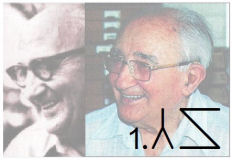 Blissymbolics, through its inventor, Charles Kaisel Bliss, established a wonderfully transparent (to those who use it), set of glyphs which integrate together with each other systematically and seemlessly according to a well defined set of principles to generate complex meanings. However, the full potential of his system has yet to emerge. The Language has been stunted in its use and development by technological hurdles which must be overcome before Bliss glyphs can effortlessly fly off a user's keyboard into cyberspace.
Blissymbolics, through its inventor, Charles Kaisel Bliss, established a wonderfully transparent (to those who use it), set of glyphs which integrate together with each other systematically and seemlessly according to a well defined set of principles to generate complex meanings. However, the full potential of his system has yet to emerge. The Language has been stunted in its use and development by technological hurdles which must be overcome before Bliss glyphs can effortlessly fly off a user's keyboard into cyberspace.
 Bliss has long needed a dream Input Method that can unleash glyph writers' freedom to innovate, while also stabilizing and refining the visual language as it freely evolves. I believe now I have that dream Input Method sufficiently conceptualized to begin rolling out the details here at SuttonGlyphs.com. But I am not a software engineer, and the features I have in mind are well beyond my simple JavaScripting abilities.
Bliss has long needed a dream Input Method that can unleash glyph writers' freedom to innovate, while also stabilizing and refining the visual language as it freely evolves. I believe now I have that dream Input Method sufficiently conceptualized to begin rolling out the details here at SuttonGlyphs.com. But I am not a software engineer, and the features I have in mind are well beyond my simple JavaScripting abilities.
The new application would be able to output the perfectly standardized original Blissymbolics faster than we can type equivalent english, but also, by checking a preference checkbox near the top-right of the screen, the user would be able to choose nonlinear Bliss which is what I am beginning to display here at SuttonGlyphs.com. This new software will be so powerfully flexible in expressing visual information that every user could have their own style of glyphs, yet the software will help guide the user to continually refine and clarify the visual language. I know this sounds like a paradox, and it was.
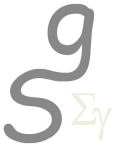 SuttonGlyphs is my attempt to morph Bliss into a dynamic, flexible and powerful tool for augmenting text. But this is just a beginning. There is no limit to how the original semantic primitives of Blissymbolics can be arranged into nonlinear patterns. And the graphic primitives of the original Blissymbolics, if expanded only slightly would be able to generate any new semantic primitives that might be needed and could also improvise all manner of diagrams of surprising detail and complexity. All these primitives, both graphic and semantic, could be derived from a small set of SVG definitions.
SuttonGlyphs is my attempt to morph Bliss into a dynamic, flexible and powerful tool for augmenting text. But this is just a beginning. There is no limit to how the original semantic primitives of Blissymbolics can be arranged into nonlinear patterns. And the graphic primitives of the original Blissymbolics, if expanded only slightly would be able to generate any new semantic primitives that might be needed and could also improvise all manner of diagrams of surprising detail and complexity. All these primitives, both graphic and semantic, could be derived from a small set of SVG definitions.


In standard bliss, we add english to the end of some symbols to add more information. If english, why not chinese? And if chinese, why not use astrological glyphs with bliss glyphs when identifying star constellations?
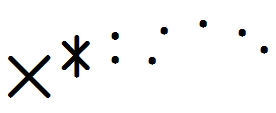
And if that's okay, why not arrange standard bliss dots in the shape of star constellations and add that to the end of bliss glyphs for 'group of stars'. And of course, why not augment each glyph as soon as we find or create a matching image? Picture a soft blue sky displaying the actual dipper. What a perfect balance to the initially cryptic looking glyphs.
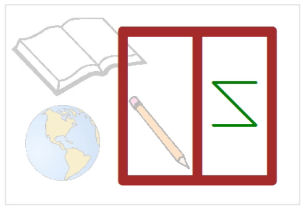 Charles Bliss' original vision was a flexible, developing visual language, not one frozen in time as it has been now for 60 years. In the beginning he seemed to trust that Bliss writers could compose glyphs themselves from the elemental, small parts available in his system. But then exaggerated fears of chaos creeping into his language seemed to lead to naiive attempts to control spelling by copyright enforcement. But how can you copyright a language without killing it?
Charles Bliss' original vision was a flexible, developing visual language, not one frozen in time as it has been now for 60 years. In the beginning he seemed to trust that Bliss writers could compose glyphs themselves from the elemental, small parts available in his system. But then exaggerated fears of chaos creeping into his language seemed to lead to naiive attempts to control spelling by copyright enforcement. But how can you copyright a language without killing it?
Charles didn't seem to realize as we do today, that verbal languages are inherently unstable but written and visual languages are not. As long as the respective written or visual language has had its gutenberg moment, stability is assured and creativity can be unleashed. That moment is now on the horizon for Bliss. We should all feel free to play with the language to our hearts content! There is no support in law for perpetual copyrights anyway. And there is nothing you can do to harm the language. The software will protect and nourish it even in conditions of complete freedom of use.
So in that spirit, let's have some fun:
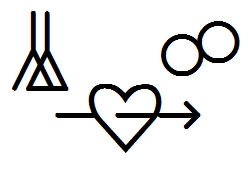
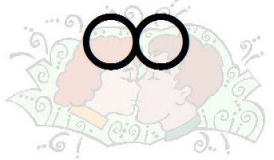
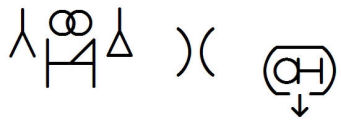
Well, let's not have that much fun ;-)
Basically, the strategy for creating these glyph patterns is to lay the glyphs out in a pattern resembling the appearance of real life situations.
Glyph patterns augmented by natural images can serve two purposes at once:
1. Convey the meaning intended across linguistic barriers, and
2. Teach the glyphs of the visual language system.
Notwithstanding my remarks above about how a nonlinear bliss-knowledge-glyph could replace (augment) a paragraph of text, some messages are inherently linear and straight to the point:
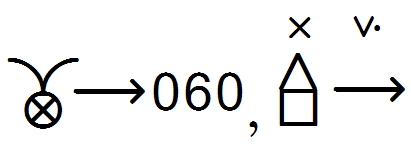
AIRCRAFT HEADING 060, ROCKETS FIRED.
By writing this message in CAPS text and linear glyphs, both lines read precisely together, word for glyph, glyph for word. Sometimes we don't want pretty pictures, although we could announce such emergency messages with an attention getting glyph:
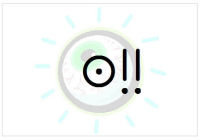
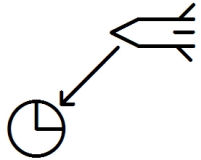
ROCKET INBOUND FROM YOUR 1 O'CLOCK
Now on to a discussion of what nonlinear representations can do for us.....
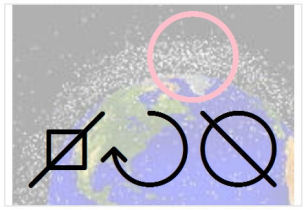 |
vs | 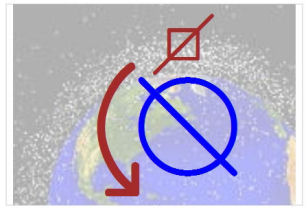 |
The augmented glyph on the left above was composed using the standard bliss method of combining elemental ideas: waste + circling + earth.
But these ideas, being strung out in a line need assembling in the mind of the reader. A bliss reader knows that the first glyph on the left is the thing itself and that the remaining glyphs are modifiers adding more information. But the uninitiated reader would be clueless as to how to assemble the meanings of the glyphs into a picture of what is going on here.
So why not assemble them!
The advantages are:
1. The nonlinear glyph on the right above explains itself with the help of the natural image augmentation.
2. The nonlinear glyph can be larger in its rectangle because it is not strung out in a line, so it reduces to a smaller, recognizable icon for use in a chatroom:
 A lot of space junk orbits the earth!
A lot of space junk orbits the earth!
Even though the natural image augmentation is not recognizable in the small icon, the glyph is. The glyph could enlarge in a chatroom when clicked or hovered over, depending on preference. The small size when not hovering for enlargement could help ween the user of dependence on the natural image augmentation, thus teaching the knowledge glyph system during use.
Now let's compare a sequence of augmented glyphs strung in a line like a sentence with the same message arranged in a nonlinear array of glyphs, really, just a diagram or map.
Take a few moments to study over the linear sequence of glyphs, and after you have an interpretation in mind, study over the same message in the nonlinear diagram.
Can you see that the diagram provides the information usually given by grammar, syntax and connecting words like over, around, on, in and under?
The diagram shows that a barbed wire fence surrounds a secret space. And it displays a military aircraft in a building inside the secret space. A fenced in secret military hangar.
Now, the diagram is 303 pixels in height because it has not been optimized for creating smaller icons, as you see here:
We can identify the hangar glyph but not the red jet image, but that's okay, it can challenge the chatroom user to remember the glyph without help from the natural image before clicking to enlarge if needed.
You may prefer the glyphs for "secret" and "barbed wire" remain difficult to see in the smaller image. But if you want all the glyphs intelligible before enlarging, no problem:
Can we agree here that Blissymbolics does not need to remain exclusively a rigid linear language, and that the potential of Blissymbolics is undiscovered at this time? Let's try and discover this potential.
About
Contact
Symbols in The News
Interpret this Symbol
AAC
African
AI
Alchemy
Alphabets
Ancient
Animal Symbolism
Architecture
Art
Articles
Astrology
Baha'i
Blissymbolics
Blueprint Symbols
Buddhist
Celtic Symbols
Cemetery
Chinese Symbols
Christian
Circle
City
Codes
Color
Conlangs
Crop Circles
Danger
Da Vinci Code
Designing Logos
Dictionaries
Dreams
Education
Egyptian Symbols
Electrical
Emoticons
Find Images
Fonts
Food
Fraternity
Hamsa
Healing
Heraldry
Hermetic
Highway Signs
Hindu
History
Hobo
Holiday
Icons
iConji
Islamic
Jain Symbols
Japanese, Kanji
Jewish
Justice
Law
Literary Symbolism
Mandalas
Map
Masonic
Math, Number
Meaning of Names
Medical
Middle East
Military
Miscellaneous
Money
Music
Mythology
Native American
Playing Cards
Power
Psychology
QiQiiKhu
Reiki
Religious
Runes, Norse
Sacred Geometry
Scientific
Science Fiction
Sorority
Sports
Symbols in the News
Tattoos
ThirteenSymbols
Tree of Life
Ursprache
Videos
Visual Languages
Weather
Web Codes
Wicca
Words
Writing Systems
Braille
Coinherence
Coptic
Cuneiform
Easter Island
Etruscan
Happy Human
Hebrew
Kokopelli
Linear B
Lotus
Love Symbols
Mandorla
Moon Alphabet
Nine Pointed Star
Om
Oz
Phonetic
Scarab Beetle
Silent
Theosophy
Unifon





